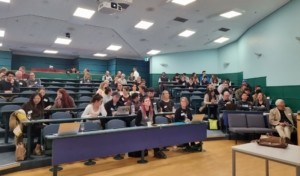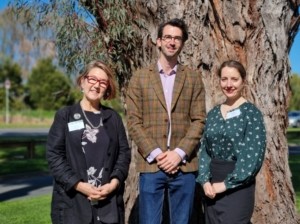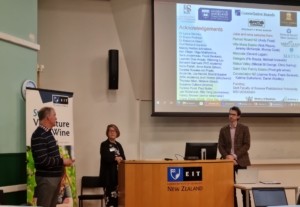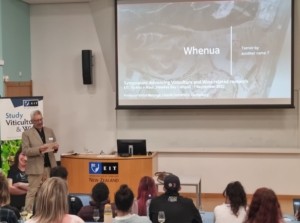
EIT’s wine research symposium was well attended by academics and industry players from around the country.
The Advancing Viticulture and Wine Related Research symposium, organised by EIT’s School of Viticulture and Wine Science and held at EIT’s Hawke’s Bay Campus last week, attracted academics and industry players from across the country in person and online.
The wine research symposium, which followed on from last year’s successful inaugural event, saw researchers from the University of Auckland, Lincoln University, Plant & Food Research, Otago Polytechnic and EIT present on Thursday.
Sue Blackmore, the Head of EIT’s School of Viticulture and Wine Science, says the interest from researchers and the industry support for these symposiums has been fantastic.
“EIT is pleased to be able to host a diverse group from across the country. It is great to see Lincoln University out in force, University of Auckland staff and students, Otago Polytechnic and Plant & Food Research representation from Marlborough and Hawke’s Bay.
“The intent of this gathering is to provide established and emerging researchers from across New Zealand research organisations, in quite diverse areas of wine related research, an opportunity to present in a formal setting and gain feedback from each other and the wine industry.”

Sue Blackmore, the Head of EIT’s School of Viticulture and Wine Science; Dr Rory Hill, EIT Programme Coordinator and Lecturer – Wine Business and Innovation; and EIT Viticulture and Wine Science lecturer Dr Chandré Honeth; at the recent wine research symposium.
About 100 people attended throughout the day to hear 16 speakers share their research across five sessions; the NZW Pinot Project, vine health, applied oenology, vineyard perspectives and the current issues facing the NZ wine industry.
Professor Paul Kilmartin, from the School of Chemical Sciences at the University of Auckland, was one of two keynote speakers.
“This is a great event for EIT and people like Sue and Rory (Dr Rory Hill, Programme Coordinator and Lecturer – Wine Business and Innovation) should be congratulated fully because there is a real need to have this for our researchers to be able to meet and interface with the wine industry.”
He presented on pre-fermentation additives that enhance varietal thiols in Pinot Gris, Chardonnay and Sauvignon Blanc wines. His work centred on the NZ Sauvignon Blanc and how what happens during harvest can change the style of wine.

One of the keynote speakers at EIT’s wine research symposium was Professor Paul Kilmartin from the School of Chemical Sciences at the University of Auckland. He presented on Pre-fermentation additives that enhance varietal thiols in Pinot Gris, Chardonnay and Sauvignon blanc wines. In the photo, Professor Kilmartin (left) is in discussion with EIT Head of the School of Viticulture and Wine Science, Sue Blackmore (middle) and Dr Rory Hill, Programme Coordinator and Lecturer – Wine Business and Innovation (right).
“The aromas are very much affected by what happens at harvest. The vineyard is important. In fact, the wisdom is the wine is made in the vineyard and the winemaker perhaps should be a bit hands off and allow the full expression of the grape.
“We know though that differences in yeast and how you make the wine are important. But that small transition period of bringing the grapes in sounds like it’s not important, but whether you machine harvest or handpick, and how many antioxidants you put in, are very important things for the style of wine you get.”
Professor Hirini Matunga (Kāti Māmoe, Ngāti Kahungunu, Ngāi Tahu and Rongowhakaata), Professor of Māori and Indigenous Development and Professor of Indigenous Planning at Lincoln University, gave the second keynote address and spoke on Whenua – Terroir by another name?

One of the keynote speakers at EIT’s wine research symposium was Professor Hirini Matunga (pictured front left) from Lincoln University’s Department of Environmental Management. He spoke on Whenua – Terroir by another name?
“I’m really drawing to attention the fact that sense of place within the context of Aotearoa can’t be seen in an a-historical way, it’s got to be seen through the prism of colonisation as well and land confiscation and the Treaty of Waitangi.”
He says this cultural, political lens has largely been absent from the discussion around wine production.
“There are very few, as I understand it, Māori wine growers and Māori wine producers and that’s been until relatively recently.”
Three current EIT researchers also presented papers. Viticulture and Wine Science lecturer Dr Chandré Honeth presented on the impact of using undervine clover to manage mealybug and leafroll virus on vine physiology and metabolism in a Merlot vineyard planted on the Gimblett Gravels.
Chandré’s colleague Dr Victor Ye spoke about sensorial characterisation by polarized partial napping and ultra-flashing profiling, while another EIT lecturer in Viticulture and Wine Science, Jane Qin’s presentation was on characterisation of commercial Hawke’s Bay Chardonnay wines – chemical composition and winemaking intentions.
